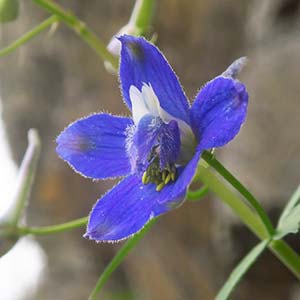Delphinium luteum
Delphinium basalticum
golden larkspur, yellow larkspur
basalt larkspur, basaltic larkspur, Columbia Gorge larkspur
20-40(-55) cm;
base often reddish, nearly glabrous.
20-50(-65) cm;
base often reddish, puberulent.
blade round to pentagonal, 1-5 × 2-10 cm, nearly glabrous; ultimate lobes 3-5, width 8-30 mm (basal), 5-15 mm (cauline).
blade round, 2-6 × 5-9 cm, not succulent, nearly glabrous; ultimate lobes 5-19, width 3-15 mm (basal), 1-12 mm (cauline).
5-25(-37)-flowered;
pedicel (1-)3-5(-7) cm, puberulent;
bracteoles 6-10(-17) mm from flowers, green, linear-lanceolate, 6-7 mm, nearly glabrous.
(2-)6-16(-26)-flowered;
pedicel 2-7 cm, nearly glabrous;
bracteoles 4-12 mm from flowers, green, linear, 3-7 mm, nearly glabrous.
sepals bright yellow, puberulent, appearing waxy, lateral sepals ± forward pointing, (11-)14-16 × (6-)9-13 mm, spur straight, ca. 30° below horizontal, 11-20 mm;
lower petal blades elevated, exposing stamens, 3-4 mm, clefts 0.5-1.5 mm;
hairs sparse or absent, ± evenly distributed if present, white to yellow.
sepals dark blue, nearly glabrous, lateral sepals spreading, 15-21 × 7-10 mm, spur straight to decurved, ascending 30-45° above horizontal, 14-18 mm;
lower petal blades slightly elevated, ± exposing stamens, 7-9 mm, cleft 4-5 mm;
hairs centered, mostly on inner lobes above base of cleft, yellow to white.
11-14 mm, 3.5-4.5 times longer than wide, glabrous.
12-17 mm, 3.5-4 times longer than wide, glabrous.
unwinged;
seed coat cell surfaces smooth.
± wing-margined;
seed coat cells with surfaces smooth.
Delphinium luteum
Delphinium basalticum
Of conservation concern.
Delphinium luteum is presently known from only three populations. It is known to hybridize with D. decorum and with D. nudicaule. Populations of D. hesperium subsp. hesperium also occur at the type locality; D. luteum flowers earlier and hybrids are not known.
Delphinium luteum is not likely to be mistaken for any other species of Delphinium. It has been treated as a variety of D. nudicaule and is closely related to that species. Sepals of the infrequent yellow-flowered phase of D. nudicaule, however, have a much drabber appearance compared with the bright shining yellow of the sepals in D. luteum.
(Discussion copyrighted by Flora of North America; reprinted with permission.)
Of conservation concern.
Hybrids between Delphinium basalticum and D. trolliifolium are known.
(Discussion copyrighted by Flora of North America; reprinted with permission.)


